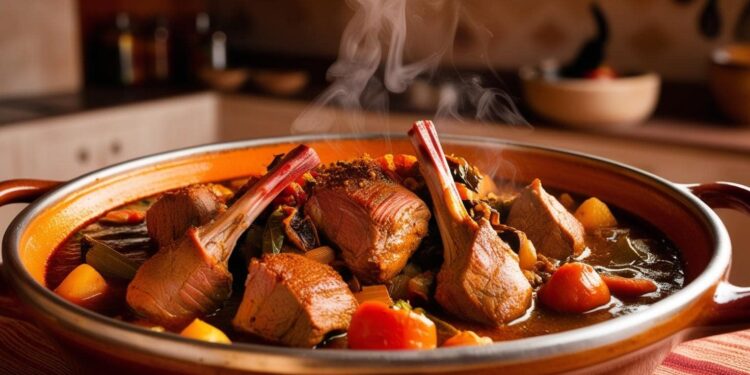Introduction: More Than Just a Meal
Imagine a table set under the golden glow of a Moroccan sunset. The air is filled with the warm aroma of cumin, saffron, and slow-cooked vegetables. In the center, a steaming Lamb Tagine Recipe gently simmers, waiting to be shared by everyone present. Moroccan food isn’t just about flavor. it’s a ritual of love, patience, and family bonding.
In this article, we explore how traditional Moroccan dishes like the tagine reflect values of togetherness, time, and heritage—offering more than nourishment, but a cultural experience that brings people closer.
The Tagine: A Symbol of Moroccan Culinary Heritage
Tagine, both the dish and the earthenware pot it’s named after, is at the heart of Moroccan cuisine. Slow-cooked and deeply flavorful, the tagine is a perfect metaphor for patience and community.
Why the Tagine is More Than a Recipe
- Patience in Cooking: Tagines are cooked slowly over low heat, sometimes for hours. This slow process allows spices and ingredients to blend deeply, reflecting the Moroccan value of taking time to do things right.
- Family Gatherings: Tagine is rarely eaten alone. It’s designed to be shared, typically placed in the center of the table as everyone eats together, directly from the pot.
- Passed Through Generations: Recipes are often inherited, passed down from mothers to daughters and grandmothers to grandchildren.
➡️ Related: Discover the Best Moroccan Street Food
Patience as a Key Ingredient in Moroccan Cuisine
Patience is a hidden yet essential ingredient in Moroccan food. Dishes like bastilla, harira, and even homemade bread require hours of preparation and care.
Why Patience Matters in Moroccan Cooking
- Flavor Development: Spices like cinnamon, turmeric, and coriander aren’t rushed. They are toasted, blended, and infused slowly for the richest taste.
- Ritual and Rhythm: Preparing food in Morocco isn’t a chore—it’s a ritual. It’s common to see families start cooking hours before a meal, with laughter, conversation, and music flowing in the kitchen.
Tip: If you’re trying Moroccan recipes at home, give yourself time. Rushing ruins the charm – and flavor.
Family First: Food as a Connection
In Moroccan culture, meals are a daily ceremony of connection. Whether it’s a large family dinner or a casual lunch with neighbors, food is always about togetherness.
How Moroccan Food Builds Bonds
- Eating from the Same Dish: Many Moroccan meals are communal, encouraging sharing and closeness.
- No Phones, Just Stories: Mealtime is a sacred space for storytelling, laughter, and reflection.
- Hospitality as a Lifestyle: Guests are treated like family. Offering a meal is one of the highest forms of respect and welcome.
➡️ More: 7 Things You Can Do If You Visit Morocco
Tagine Recipes That Celebrate Family
Want to bring a taste of Morocco into your home? Here are a few tagine ideas that embrace tradition and love:
- Chicken Tagine with Preserved Lemons & Olives
- A balance of tangy, salty, and rich.
- A balance of tangy, salty, and rich.
- Lamb Tagine with Prunes and Almonds
- Sweet and savory, often served at weddings or special gatherings.
- Sweet and savory, often served at weddings or special gatherings.
- Vegetable Tagine
- A wholesome, hearty dish ideal for family meals or vegan diets.
- A wholesome, hearty dish ideal for family meals or vegan diets.
Pro Tip: Use authentic Moroccan spices and a traditional tagine pot for the best results.
Lamb Tagine Recipe: A Slow-Cooked Celebration of Family and Patience
The Lamb Tagine with Prunes and Almonds is a quintessential Moroccan dish that exemplifies the virtues of patience and family in the kitchen. This dish is prepared slowly, allowing the lamb to become incredibly tender as it soaks in the rich flavors of cinnamon, saffron, ginger, and garlic, while the prunes add a natural sweetness and the almonds provide a delightful crunch.
The slow-cooking process not only enhances the depth of flavors but also mirrors the Moroccan cultural practice of taking time to perfect every meal. Often served during festive occasions like weddings, family reunions, and celebrations, Lamb Tagine is more than just a meal. it’s a symbol of sharing, patience, and the importance of coming together. The long hours of cooking create an opportunity for families to bond over the preparation, making this dish a true reflection of the values of Moroccan hospitality and familial connection.
Bringing Moroccan Patience Into Your Kitchen
Adopting Moroccan cooking techniques in your own kitchen can bring mindfulness and togetherness into your daily life.
Actionable Tips:
- Set aside time to cook slowly, without multitasking.
- Invite friends or family to join the cooking process.
- Use the moment as an opportunity to disconnect from screens and reconnect with people.
- Play Moroccan music while you cook. immerse yourself in the experience.
Conclusion: Slow Food, Stronger Bonds
Moroccan food teaches us some of the best things in life. like flavor, love, and connection. take time. Through the humble tagine, Moroccan families have celebrated life’s joys and sorrows together, one slow-cooked meal at a time.
If you’re looking to slow down, connect with loved ones, and experience food with your heart (not just your mouth), then take a page from Moroccan tradition. Cook a tagine, gather your people, and let the flavors do the rest.
💬 Have you ever tried a Moroccan tagine or shared a slow-cooked meal with loved ones? Share your experience in the comments below!










































